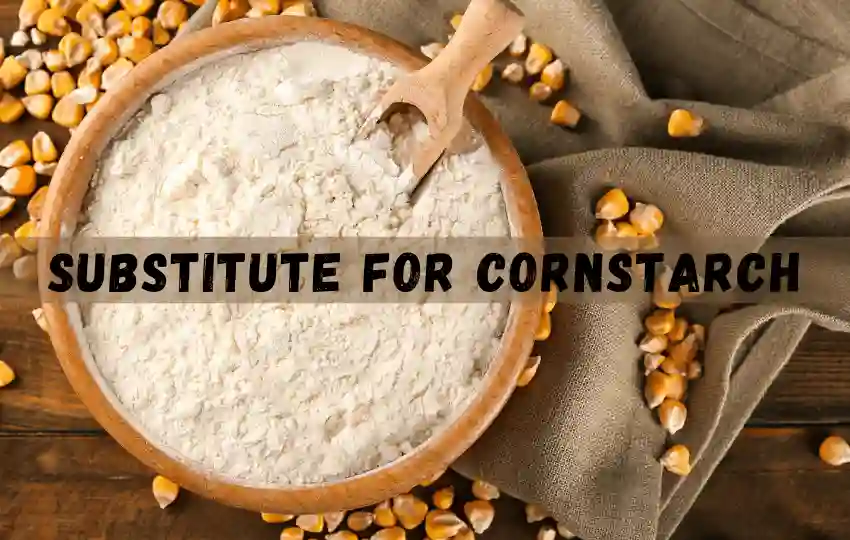Cornstarch is a versatile ingredient that’s widely used in various dishes – from thickening sauces to creating crispy coatings for fried foods.
However, not everyone has this pantry staple in their kitchen, or some may be allergic to it.
The good news is that you can substitute cornstarch with many other ingredients that are equally effective.
In this blog post, we’ll share 14 of the best substitutes for cornstarch with ratios and tips on how to use them.
In short, " What can I use instead of cornstarch?" Arrowroot Powder, Potato Starch, Tapioca Starch, Rice Flour, All-Purpose Flour, Wheat Flour, Xanthan Gum, Guar Gum, Gelatin, Agar-Agar, Flour, Carrageenan, Kuzu, Corn Flour.
What is cornstarch, and what does cornstarch taste like?
Cornstarch is a powder produced from the endosperm of corn kernels. It is commonly used as a thickening agent in sauces, gravies, pies, puddings, and other desserts.
Cornstarch has a bland taste and does not alter the flavor of a dish significantly when added.
It tends to take on the flavor of whatever it’s mixed with, so it can go largely unnoticed when incorporated into a recipe.
Uses of cornstarch
Cornstarch is an important ingredient in many recipes and cooking techniques, offering a wide range of benefits to enhance flavor and texture.
For starters, cornstarch is a great binding agent for certain dishes. In particular, it can be used to hold together foods, such as meatballs or croquettes, that are normally difficult to form.
When added to wet ingredients, it helps bind the mixture together and prevents them from falling apart.
Additionally, it’s useful in thickening sauces and gravies by absorbing some of the liquid and making the mixture more viscous.
Cornstarch is also often used in baking recipes where gluten-free ingredients are needed.
Since it doesn’t contain gluten proteins like wheat flour does, it provides a viable option for those with celiac sickness or other gluten sensitivities who wish to enjoy homemade baked goods.
Unlike other starches like potato starch, cornstarch imparts a light flavor which makes it ideal for desserts like custards or creams.
In terms of texture enhancement, cornstarch is an effective choice for many fried foods as well.
By coating food items with a thin layer of cornstarch prior to frying, the end result will be crispier than if they had been fried without any extra coating.
This technique is known as tempura-style frying and can be seen in various classic dishes such as General Tso’s Chicken or Japanese eggplant fries.
As an alternative to battering and deep-frying certain items (which may add extra fat content), using cornstarch offers a healthier alternative while still preserving desirable crunchy textures.
Overall, there’s no denying that cornstarch has its place in the kitchen pantry due to its versatile uses when cooking or baking.
It’s an economical way to enhance flavors and textures while adding valuable nutrition benefits to your meals!
Where to buy cornstarch?
If you are looking for where to buy cornstarch, there are a few different places you can go. Many specialty food stores carry it, as do some international grocery stores.
You can also order online from many retailers that provide a variety of diverse flavors and types of cornstarch.
Best substitutes for cornstarch with a ratio
1. Arrowroot Powder – a good substitute for cornstarch
Arrowroot powder is a starch that’s derived from the root of the arrowroot plant. It has a neutral taste and can be used in the same way as cornstarch.
Ratio or measurement: To substitute, use two tablespoons of arrowroot powder for every tablespoon of cornstarch.
2. Potato Starch

Potato starch is produced by extracting starch from potatoes, and it has a similar texture to cornstarch.
It’s a great alternative for thickening sauces and soups.
Ratio or measurement: To substitute, use two tablespoons of potato starch for every tablespoon of cornstarch.
3. Try Tapioca Starch in place of cornstarch
Tapioca starch is removed from the roots of the cassava plant. It has a slightly sweet taste and is commonly used in Asian cooking.
It’s an excellent substitute for cornstarch in recipes that require a clear and glossy finish.
Ratio or measurement: To substitute, use two tablespoons of tapioca starch for every tablespoon of cornstarch.
4. Rice Flour
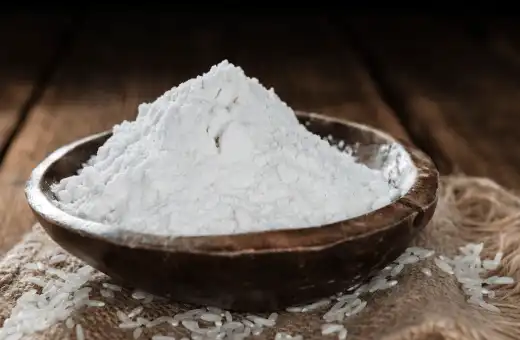
Rice flour is produced from finely ground rice grains. It’s often used in gluten-free baking and has a similar texture to cornstarch.
Ratio or measurement: To substitute, use two tablespoons of rice flour for every tablespoon of cornstarch.
5. All-Purpose Flour – a great alternative for cornstarch
All-purpose flour can use as a substitute for cornstarch in a pinch. It’s not as effective as other starches in thickening sauces, but it still gets the job done.
Ratio or measurement: To substitute, utilize two tablespoons of all-purpose flour for each tablespoon of cornstarch.
6. Wheat Flour
Wheat flour can work as a cornstarch substitute, but it needs to be cooked for a longer time to thicken properly.
It’s best used in recipes that require a roux, like gravies or béchamel sauce.
Ratio or measurement: To substitute, use two tablespoons of wheat flour for every tablespoon of cornstarch.
7. You can use Xanthan Gum instead of cornstarch
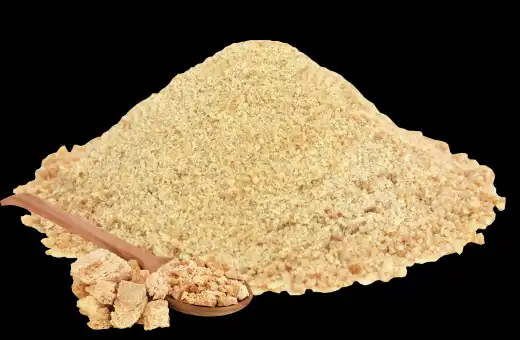
Xanthan gum is a natural thickener that’s commonly used in gluten-free baking. It has a unique texture that’s perfect for sauces and gravies.
Ratio or measurement: To substitute, use a 1/2 teaspoon of xanthan gum for every tablespoon of cornstarch.
8. Guar Gum
Guar gum is produced from the seeds of the guar bean, and it’s a great alternative to cornstarch. It works well in recipes that require a smooth texture and glossy finish.
Ratio or measurement: To substitute, use a 1/2 teaspoon of guar gum for every tablespoon of cornstarch.
9. Gelatin – a decent replacement for cornstarch
Gelatin is a protein that’s extracted from animal collagen. It’s commonly used in desserts and jellies but can also be used as a thickener for sauces.
Ratio or measurement: To substitute, use one tablespoon of unflavored gelatin for every tablespoon of cornstarch.
10. Agar-Agar
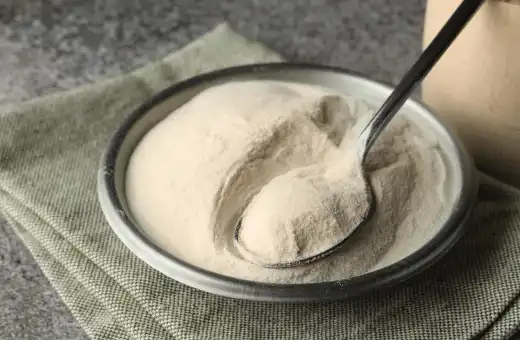
Agar-agar is a vegetarian substitute for gelatin that’s made from seaweed. It has a similar texture to gelatin and works well in desserts and jellies.
Ratio or measurement: To substitute, use one tablespoon of agar-agar powder for every tablespoon of cornstarch.
11. Flour – similar taste to cornstarch
Flour is an excellent substitute for cornstarch.
Ratio or measurement: Replace one tablespoon of cornstarch with two tablespoons of flour.
Keep in mind that flour has a lower thickening ability, so you’ll need to use more of it. It’s best to use in gravies, sauces, and soups.
Just add it to the liquid while stirring constantly. Simmer it for a couple of minutes to thicken.
12. Carrageenan
Carrageenan is a natural thickener extracted from seaweed and is vegan-friendly. It works great in dairy products, such as yogurt and ice cream.
It’s also perfect for thickening sauces and soups.
Ratio or measurement: Replace one tablespoon of cornstarch with one tablespoon of carrageenan. Mix with cold water before adding it to the liquid.
Simmer while stirring until it thickens.
13. Kuzu – An ideal substitute for cornstarch
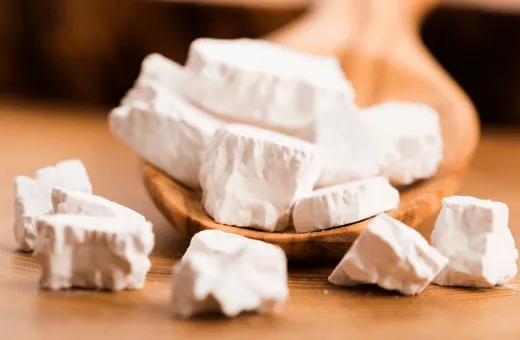
Kuzu is a root starch that works great as a thickener. It’s perfect for sauces, gravies, stews, and glazes.
Ratio or measurement: Replace one tablespoon of cornstarch with two tablespoons of kudzu.
Mix with cold water before adding it to the liquid. Cook until the mixture thickens.
Recommended: The Best Substitute For Kuzu
14. Corn Flour
Corn flour is produced from whole corn kernels and is often confused with cornmeal. It’s perfect for thickening and adding texture to dishes.
Ratio or measurement: Replace one tablespoon of cornstarch with two tablespoons of corn flour. Mix it with cold water before adding it to the liquid.
Cook it over medium heat till it condenses.
Tips on How to Choose the Most Suitable Substitution Option for Cornstarch
When selecting a substitution option for cornstarch, consider the following tips:
1. Purpose: Determine the purpose of cornstarch in your recipe. Cornstarch is commonly utilized as a thickening agent, but it can also contribute to the texture and consistency of baked goods.
Look for a substitution option that can fulfill the desired function.
2. Thickening alternatives: If you need a thickening agent, there are several alternatives to cornstarch. These include arrowroot starch, tapioca starch, potato starch, and rice flour.
Each of these options can provide similar thickening properties, but they may have slightly different textures and flavors.
3. Texture considerations: Consider the texture you want to achieve in your recipe. Cornstarch is known for creating a smooth and glossy texture.
Choose a substitute that can help achieve a similar texture based on your preference and the specific recipe.
4. Flavor neutrality: Cornstarch is relatively flavorless, allowing it to blend seamlessly with other ingredients.
If you’re looking for a substitution option that won’t impact the taste of your dish, opt for an alternative with a neutral flavor.
5. Substitution ratios: Take note of the recommended substitution ratios. Different alternatives may require different ratios compared to cornstarch.
Follow the guidelines provided with the substitution option or consult reliable sources for appropriate conversion measurements.
6. Allergies and dietary restrictions: Consider any allergies or dietary restrictions you or your intended audience may have.
For example, if you require a gluten-free option, opt for gluten-free alternatives like arrowroot starch or tapioca starch.
7. Availability and accessibility: Check the availability of the substitution option in your local stores or online. Some alternatives may be more readily available than others, depending on your location.
the most common cornstarch substitute for thickening
One common cornstarch substitute that can be used for thickening is arrowroot powder. It is a starch made from the root of a tropical plant, usually harvested in South America and Asia.
Arrowroot has a neutral taste, and its thickening power is similar to cornstarch.
When used as a thickener, it produces a glossy sheen and clear consistency in sauces or soups that stays glossy when chilled.
It works best when mixed with cold liquids first before adding them to hot dishes. Arrowroot is also gluten-free, so it’s a great choice for folks who are avoiding gluten.
Other alternatives include tapioca flour, rice flour, potato starch, and psyllium husk powder.
All of these starches act similarly to cornstarch in terms of thickening power; however, they each have their own unique flavor and texture characteristics that you should consider before making your selection for particular recipes.
Conclusion on substitute for cornstarch
Substituting cornstarch in your favorite recipes can seem daunting, but with this list, you should be able to tackle any dish.
Remember to keep in mind the different ratios and cooking times for each substitute.
With these options, you can get creative with your cooking while still maintaining the consistency of your dish. Don’t let the lack of one ingredient stop you from creating your favorite recipe.
FAQs on substitute for cornstarch
Q1. What is similar to cornstarch?
Other similar ingredients to cornstarch include arrowroot starch, potato starch, tapioca starch, rice flour, and wheat flour.
All of these can be used as thickening agents for sauces and gravies, although some may alter the flavor slightly. Cornstarch is generally preferred because it produces a more neutral flavor when cooked.
Q2. Can I use flour instead of cornstarch?
Yes, flour can be used as an alternative to cornstarch. Flour has a higher starch content than cornstarch, which means it will act as a thickening agent in recipes.
However, it is important to note that when using flour instead of cornstarch, you should use twice as much flour as the amount of cornstarch the recipe calls for.
Additionally, you should stir the mixture often while cooking so that lumps do not form. This is because flour has a tendency to clump up easier than cornstarch.
Furthermore, when using flour for thickening sauces or soups, it’s best to add it slowly and allow the mixture to simmer for a while before serving since this allows time for all of the flavors and ingredients to combine and thicken properly.
Q3. Can I use flour rather than cornstarch for frying?
Yes, you can use flour rather than cornstarch for frying. Flour is a fine-textured powder made from wheat, rice, or other grains and is used to make bread and pastries.
When used as a coating for fried foods, it creates a crispy exterior that locks in moisture and flavor.
However, it should be noted that the coating will not be as crisp as when using cornstarch. Additionally, since flour has more gluten than cornstarch, you may find that the coating absorbs more grease during cooking.
Therefore, if you’re looking for a light and crispy fried food experience, then cornstarch is preferred over flour.
Q4. Can I use Maida instead of cornflour?
Yes, you can use Maida instead of Cornflour. Maida is a finely milled white flour made from the endosperm of wheat grains and is widely used in Indian cuisine. It is typically used to make bread, pastries, and various other baked goods.
Maida can be used as a thickening agent in gravies and sauces, as it absorbs water and has a smooth texture when cooked. It can also be used to dust food items such as Pakodas for better crispness and flavor.
In certain areas of India, like Punjab, Maida is even used to prepare traditional unleavened bread like paratha or chapati.
Q5. Can besan be used instead of cornflour?
Yes, besan (also known as gram flour or chickpea flour) can substitute for corn flour in certain recipes. However, it’s important to note that besan has a distinct flavor and texture that may affect the final outcome of the dish. Here are some tips on using besan as a substitute for cornflour:
1. Thickening: Cornflour is often used as a thickening agent in sauces, gravies, and soups. Besan can also serve as a thickener, but it has a slightly grainy texture and may impart a nutty flavor.
Adjust the amount of besan based on the desired thickness and consider the impact on the overall taste.
2. Binding: Besan can work as a binding agent in recipes such as fritters, batters, and coatings for fried foods. Its binding properties make it a suitable alternative to cornflour in these applications.
3. Flavor profile: Besan has a distinctive nutty and earthy flavor, while cornflour is more neutral in taste. When substituting besan for cornflour, be aware that the flavor profile of the dish may be affected. Consider whether the nutty taste of besan complements the other ingredients in the recipe.
4. Gluten-free option: Besan is naturally gluten-free, making it a suitable choice for individuals with gluten sensitivities or dietary restrictions.
If you need a gluten-free substitute for cornflour, besan can be a good option.
5. Recipe compatibility: Some recipes may be more forgiving in terms of substituting cornflour with besan.
Traditional Indian dishes like pakoras or kadhi often use besan as a thickener, so it can easily replace cornflour in those recipes.
However, in recipes where cornflour is used for its specific properties, such as in delicate baked goods, besan may not be the most suitable substitute.
Q6. How much corn flour instead of cornstarch?
When substituting cornstarch with corn flour, the general rule of thumb is to use twice the amount of corn flour.
This is because corn flour is less processed and contains more protein and fiber compared to cornstarch, which affects its thickening power.
For example, if a recipe wants 1 tablespoon of cornstarch, you would use 2 tablespoons of corn flour. However, keep in mind that the texture may differ slightly, as corn flour has a slightly grainier texture.
Additionally, corn flour may have a stronger corn flavor compared to cornstarch, so consider the impact on the overall taste of the dish. It’s always a good idea to test the substitution in a small portion of the recipe before making it in larger quantities.
Q7. Is cornstarch similar to baking powder?
No, cornstarch is not similar to baking powder. They are two different ingredients with distinct properties and uses in cooking and baking.
Cornstarch is a fine, granular starch derived from corn. It is primarily used as a thickening agent in recipes to add viscosity and create a smooth texture.
It is commonly used in sauces, gravies, and puddings to thicken and stabilize them.
On the other hand, baking powder is an adjuvant agent to help baked goods rise. It combines baking soda, an acid (such as cream of tartar), and a moisture-absorbing agent (usually cornstarch).
When mixed with moisture and heat, baking powder releases carbon dioxide gas, causing the dough or batter to rise.
While both cornstarch and baking powder are powders used in cooking and baking, their purposes and effects on recipes are different.

